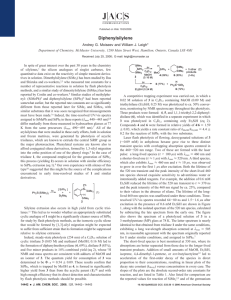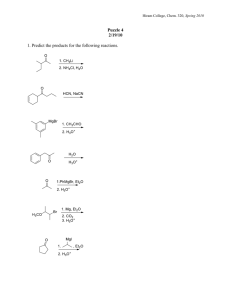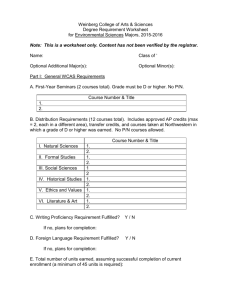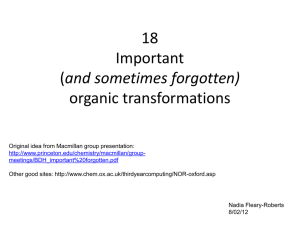437k pdf - International Union of Pure and Applied Chemistry
advertisement
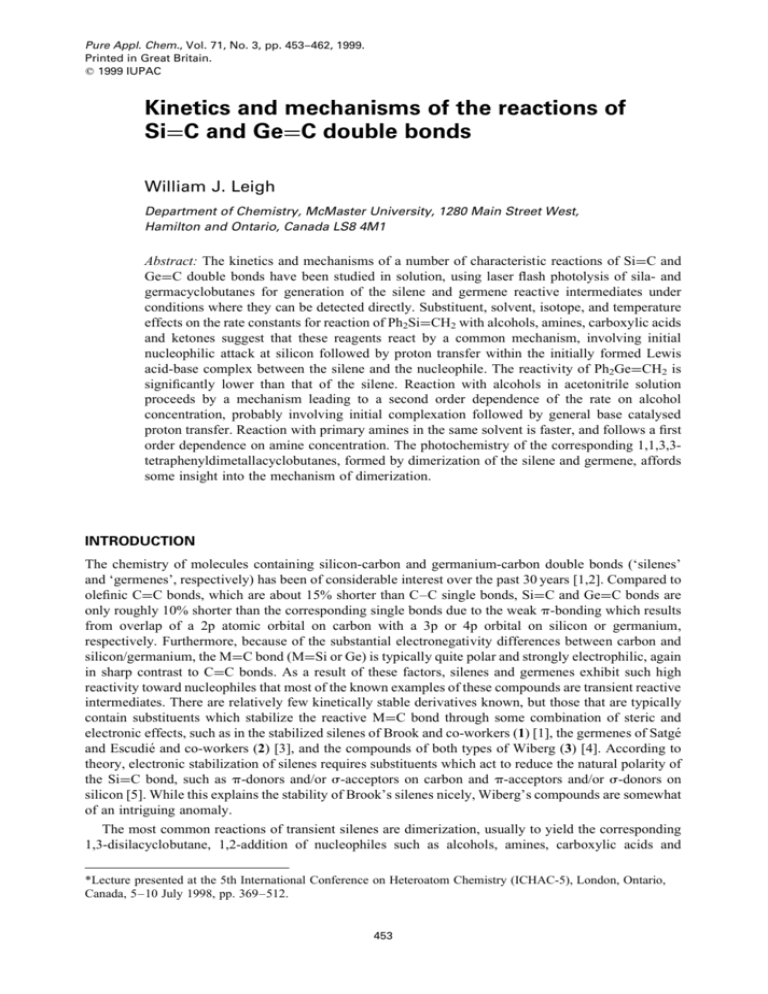
Pure Appl. Chem., Vol. 71, No. 3, pp. 453–462, 1999. Printed in Great Britain. q 1999 IUPAC Paper 185 Kinetics and mechanisms of the reactions of Si¼C and Ge¼C double bonds William J. Leigh Department of Chemistry, McMaster University, 1280 Main Street West, Hamilton and Ontario, Canada LS8 4M1 Abstract: The kinetics and mechanisms of a number of characteristic reactions of Si¼C and Ge¼C double bonds have been studied in solution, using laser flash photolysis of sila- and germacyclobutanes for generation of the silene and germene reactive intermediates under conditions where they can be detected directly. Substituent, solvent, isotope, and temperature effects on the rate constants for reaction of Ph2Si¼CH2 with alcohols, amines, carboxylic acids and ketones suggest that these reagents react by a common mechanism, involving initial nucleophilic attack at silicon followed by proton transfer within the initially formed Lewis acid-base complex between the silene and the nucleophile. The reactivity of Ph2Ge¼CH2 is significantly lower than that of the silene. Reaction with alcohols in acetonitrile solution proceeds by a mechanism leading to a second order dependence of the rate on alcohol concentration, probably involving initial complexation followed by general base catalysed proton transfer. Reaction with primary amines in the same solvent is faster, and follows a first order dependence on amine concentration. The photochemistry of the corresponding 1,1,3,3tetraphenyldimetallacyclobutanes, formed by dimerization of the silene and germene, affords some insight into the mechanism of dimerization. INTRODUCTION The chemistry of molecules containing silicon-carbon and germanium-carbon double bonds (‘silenes’ and ‘germenes’, respectively) has been of considerable interest over the past 30 years [1,2]. Compared to olefinic C¼C bonds, which are about 15% shorter than C–C single bonds, Si¼C and Ge¼C bonds are only roughly 10% shorter than the corresponding single bonds due to the weak p-bonding which results from overlap of a 2p atomic orbital on carbon with a 3p or 4p orbital on silicon or germanium, respectively. Furthermore, because of the substantial electronegativity differences between carbon and silicon/germanium, the M¼C bond (M¼Si or Ge) is typically quite polar and strongly electrophilic, again in sharp contrast to C¼C bonds. As a result of these factors, silenes and germenes exhibit such high reactivity toward nucleophiles that most of the known examples of these compounds are transient reactive intermediates. There are relatively few kinetically stable derivatives known, but those that are typically contain substituents which stabilize the reactive M¼C bond through some combination of steric and electronic effects, such as in the stabilized silenes of Brook and co-workers (1) [1], the germenes of Satgé and Escudié and co-workers (2) [3], and the compounds of both types of Wiberg (3) [4]. According to theory, electronic stabilization of silenes requires substituents which act to reduce the natural polarity of the Si¼C bond, such as p-donors and/or s-acceptors on carbon and p-acceptors and/or s-donors on silicon [5]. While this explains the stability of Brook’s silenes nicely, Wiberg’s compounds are somewhat of an intriguing anomaly. The most common reactions of transient silenes are dimerization, usually to yield the corresponding 1,3-disilacyclobutane, 1,2-addition of nucleophiles such as alcohols, amines, carboxylic acids and *Lecture presented at the 5th International Conference on Heteroatom Chemistry (ICHAC-5), London, Ontario, Canada, 5–10 July 1998, pp. 369–512. 453 454 W. J. LEIGH Scheme 1 alkoxysilanes, ene-addition with enolizable ketones, alkenes and dienes, and formal [2þ4]- and [2þ2]cycloaddition with dienes and nonenolizable ketones and aldehydes (Scheme 2) [1]. For the most part, the same reactions are common to germenes as well [2–4]. While the regio-and stereochemistries of these reactions are well-known, their mechanisms have not been studied in detail and are rather poorly understood. Over the past several years, our work has been directed at applying the standard techniques of physical organic chemistry to the study of the mechanisms of many of these reactions. We have focused our efforts on transient silenes and germenes, and employed laser flash photolysis techniques to generate them from stable photochemical precursors, detect them directly, and measure absolute rate constants for their bimolecular reactions as a function of substituent, solvent, isotope, and temperature. This paper presents a review of some of this work, emphasizing the kinetic and mechanistic differences between what would appear to be the common chemistry of silenes and germenes. Scheme 2 PHOTOCHEMICAL PRECURSORS OF TRANSIENT SILENES AND GERMENES One of the most versatile classes of compounds for the photochemical generation of transient silenes is silacyclobutanes, as they can be readily synthesized with a wide variety of substituents at silicon and their photolysis usually results in the formation of the corresponding 1,1-disubstituted silene and ethylene as the only products, with reasonably high quantum efficiency. 1,1-Diphenylsilacyclobutane (4a; eqn 1, Scheme 3) was one of the first compounds of this type to be shown to yield products consistent with the formation of a transient silene upon photolysis in solution [6]. The quantum yield for formation of 1,1diphenylsilene (5a) from 4a (F < 0.21 [7]) is more than adequate to make it an ideal precursor of this silene for time-resolved spectroscopic experiments [7–10]. Para substituents on the phenyl rings of 4a, such as methyl and trifluoromethyl (4b and 4c, respectively) have little effect on the photochemistry of the precursor, but significant and mechanistically informative effects on the reactivities of the resulting silenes [9,10]. One might expect germetanes to behave analogously, and indeed, 1,1-diphenylgermetane (6) proves to be an efficient photochemical source of 1,1-diphenylgermene (7) for study by flash photolysis methods [11]. q 1999 IUPAC, Pure Appl. Chem. 71, 453–462 Reactions of Si¼C and Ge¼C double bonds 455 Scheme 3 The chromophore in these compounds is obviously the aryl substituent, whose reasonably high absorptivity in the mid-UV makes it possible to use 248-nm laser radiation for silene generation. Replacing both aryl groups in 4 with alkyl, vinyl, ethynyl or trimethylsilyl groups (e.g. 8) moves the absorption maximum to < 200-nm and makes it necessary to use 193-nm laser radiation to induce photofragmentation to the corresponding silenes 9 (eqn 3) [12,13]. Again, the silenes can be readily detected by (193-nm) laser flash photolysis in hydrocarbon solution, and absolute rate constants for their reactions with aliphatic alcohols can be determined [13]. The rate constants for reaction of these silenes with methanol correlate (r2 ¼ 0.965) with the three parameter substituent constant function: log kMeOH ¼ –3.6sR8 þ 3.1sI þ 0.2Es, where sR8, sI and Es are the standard resonance, inductive and steric substituent constants, respectively. This correlation indicates that the reactivity of the Si¼C bond is increased by resonance electron donor and/or inductive electron acceptor substituents at silicon, moderated by steric effects. These results agree with predictions based on ab initio calculations of the Si¼C bond lengths and charge distributions in substituted silenes of the type H(R)Si¼CH2, which indicate that substituents of this type act mainly to reinforce the polarization of the Si¼C bond in silene, thus increasing the degree of electrophilicity at silicon [5]. KINETIC STUDIES OF THE REACTIONS OF TRANSIENT SILENES AND GERMENES Laser flash photolysis of 4a in hexane solution at 23 8C leads to the formation of a transient which decays with mixed first-and second-order kinetics over several tens of microseconds, and exhibits a UV spectrum with lmax ¼ 325-nm [7]. The lifetime of the transient is extremely sensitive to the presence of water or alcohols. On the basis of these and various other pieces of evidence, the transient can be assigned to 1,1diphenylsilene (5a) [14]. A transient with nearly identical spectral characteristics is observed from flash photolysis of the germanium analog 6, and has been assigned to the germene 7 [11]. The lifetime of the germene is also sensitive to water and alcohols, but much less so than is the corresponding silene. In scrupulously dry solution, both 5a and 7 decay with second order kinetics due to [2þ2]-dimerization to the corresponding 1,3-dimetallacyclobutanes 10 and 11 (eqn 4) which have been isolated from preparative scale photolyses and identified by X-ray crystallography [15]. The silene dimer 10 was previously known [16]. Scheme 4 Dimerization of Ph2M¼CH2 The mechanism of the [2þ2]-dimerization of silenes and germenes has been the subject of some theoretical controversy, but has not yet been studied experimentally in much detail. Seidl, Grev & Schaefer studied the dimerization of silene (H2Si¼CH2) by ab initio methods, and concluded that the process proceeds by a concerted, [p2sþp2s] cycloaddition mechanism, made kinetically favorable by relaxation of orbital symmetry restrictions due to the high polarity of the Si¼C bond [17]. More recently, Bernardi and co-workers re-examined the reaction using CASSCF methods, with which they located a lower energy, nonconcerted pathway involving a 1,4-biradical intermediate [18]. q1999 IUPAC, Pure Appl. Chem. 71, 453–462 456 W. J. LEIGH Scheme 5 Recent work from our laboratory on the photochemistry of the 1,3-dimetallacyclobutanes 10 and 11 offers some preliminary information on the behavior of the 1,4-biradical intermediates linking silene 5a and germene 7 with their corresponding dimers via the stepwise mechanism [15]. Direct photolysis of the two compounds in methanolic hexane solution leads to very different results: little reaction after hours of photolysis in the case of 10, but quantitative formation of methoxymethyldiphenylgermane (13) from photolysis of 11 (eqn 5). Flash photolysis of 11 verifies that germene 7 is indeed formed under these conditions. Similar experiments with 10 also verify that its photolysis does not lead to the formation of silene 5a in detectable yields. That 10 is relatively unreactive comes as no surprise, as it has long been known that photolysis of related compounds in the presence of methanol leads to cis,trans-isomerization and ring-opening products, but no alkoxysilane due to trapping of the corresponding silene [19,20]. This suggests that photolysis induces Si-C bond homolysis to yield the corresponding 1,4-silyl-alkyl biradical 14a, which decays only by recoupling to generate the precursor or its geometric isomer after Si-C bond rotation. It can thus be concluded that cleavage of the biradical to yield the silene has a substantially higher barrier than that for coupling. On the other hand, the activation barrier to cleavage of the germylalkyl biradical 14b must be significantly lower, allowing this process to compete with coupling to regenerate the digermetane. These differences in the reactivities of 14a and 14b are consistent with germene 7 possessing a greater degree of thermodynamic stability compared to its silicon analog 5a. Scheme 6 Reactions of Ph2M¼CH2 with nucleophiles In the presence of representative silene/germene trapping reagents such as n-butyl amine (n-BuNH2), methanol (MeOH), t-butanol (t-BuOH), acetic acid (HOAc), acetone and pivalaldehyde, the decays of 5a and 7 are enhanced and obey pseudo-first order kinetics [7–11,21]. Plots of the decay rate constant (kdecay) vs. trapping agent concentration ([Q]) according to eqn 7 are linear for both the silene and the germene in hexane solution. ð7Þ kdecay ¼ k0 þ kq ½Qÿ The slope and intercept of such a plot affords the 2nd order rate constant for quenching of the transient by Q (kq) and the pseudo-first order rate constant for decay of the transient in the absence of trapping agent (k0), respectively. These plots are well-behaved for trapping of 5a by the six reagents, but those for quenching of 7 with n-BuNH2 and the two aliphatic alcohols have negative intercepts, indicating that (in hexane at least) these are not simple second order reactions, and so little mechanistic significance is contained in the rate constants for quenching of the germene. Nevertheless, the data in Table 1 allows Scheme 7 q 1999 IUPAC, Pure Appl. Chem. 71, 453–462 Reactions of Si¼C and Ge¼C double bonds 457 Table 1 Absolute rate constants for reaction of Ph2M¼CH2 with nucleophiles in hexane solution at 23 8C* kq (108/M/s) Reagent Ph2Si¼CH2 (5a) Ph2Ge¼CH2 (7) n-BuNH2† MeOH t-BuOH HOAc Me2C¼O t-BuCHO† 97 6 4 19 6 2 4.0 6 0.7 31 6 3 3.8 6 0.2 2.9 6 0.3 0.5 6 0.1 3.6 6 0.4 0.35 6 0.03 16 6 2 < 0.004 0.044 6 0.006 * Data from [7,11] unless otherwise noted. † W.J. Leigh, N.P. Toltl, to be published. qualitative comparisons between the reactivity of 5a and 7 to be made. The germene is significantly less reactive than the silene toward all the nucleophiles studied. The largest difference in reactivity occurs for acetone, which undergoes formal ene-addition with 5a to yield the corresponding silyl enol ether but undergoes no detectable reaction with 7. The reaction of 5a and 7 with pivalaldehyde likely yields the corresponding 1,2-metallaoxetane derivative [3], although attempts to verify this through product studies have so far been unsuccessful. Addition of alcohols The addition of alcohols to transient silenes is mechanistically the best understood of the many characteristic nucleophilic trapping reactions of silenes. It is thought to proceed by initial nucleophilic attack at silicon to yield a zwitterionic complex, which collapses to alkoxysilane by proton transfer from oxygen to the silenic carbon. Proton transfer takes place by two competing pathways: one involving intramolecular migration within the silene-alcohol complex, and one involving a second molecule of alcohol (see Scheme 8). The latter pathway increases in importance with increasing alcohol concentration, and is revealed by a change in the stereo- [22] or regiochemistry of addition in selected silenes [23,24] as well as a quadratic dependence of silene decay rate on alcohol concentration [24,25]. Kira and co-workers first suggested that this process occurs by a protonation/deprotonation sequence [22], although subsequent kinetic evidence better supports a general base catalysis mechanism (i.e. deprotonation/protonation) [24]. The proposed intermediacy of a silene-alcohol complex is further supported by Wiberg’s isolation of a stable silene–tetrahydrofuran complex [26], and the observation of significant red-shifts in the UV absorption spectra of transient silenes in THF solution compared to other solvents [7,24]. More easily intepretable kinetic data for the reactions of 5a and 7 with alcohols can be obtained in acetonitrile solution, where potential kinetic complexities owing to alcohol self-association cannot arise [7,11]. The plots of kdecay vs. [ROH] for quenching of the two compounds by MeOH and t-BuOH in this solvent are shown in Fig. 1. The plots for the silene are clearly linear for both alcohols, indicating that the reaction is strictly first order in [ROH] over the concentration range studied. Kinetic deuterium isotope effects on the order of kROH/kROD ¼ 1.5 are observed for both alcohols; these are small but clearly primary effects, indicating that proton transfer is involved in the rate-determining step for reaction. The results are compatible with the mechanism shown in Scheme 8, with proton transfer occurring solely by the intracomplex pathway at the alcohol concentrations employed for our kinetic experiments. For germene 7 on the other hand, kdecay varies cleanly with the square of the alcohol concentration, indicating that the germene reacts exclusively by a mechanism involving two molecules of alcohol [11]. This is again compatible with the mechanism of Scheme 8, if proton transfer occurs solely by the general basecatalysed route. We believe that the different kinetic behavior of 5a and 7 is due primarily to the nature of the complex formed in the initial step of the reaction: the lower oxophilicity of Ge compared to Si should result in a weaker complex with ROH, which should result in less charge development in the zwitterion and hence a slower rate constant for intramolecular proton transfer. The weaker Lewis acidity q1999 IUPAC, Pure Appl. Chem. 71, 453–462 458 W. J. LEIGH Fig. 1 Plots of kdecay vs. [ROH] for reaction of 5a and 7 with MeOH and t-BuOH in MeCN solution at 23 8C. Adapted with permission from [7,11]. q 1996 and 1998 American Chemical Society. Scheme 8 of 7 compared to 5a is evident in the magnitude of the spectral shifts observed for the two transients in THF compared to MeCN solution [7,11]. The rate constants for addition of MeOH, MeOD and t-BuOH to silene 5a decrease with increasing temperature, resulting in negative Arrhenius activation energies for these reactions [8,9]. The Arrhenius plots for these three alcohols are shown in Fig. 2. Negative Arrhenius activation energies are frequently observed for very fast reactions which proceed by the type of mechanism given by the first two steps in Scheme 8, and arise when the rate constant for collapse of the intermediate is dominated by entropic factors, so that the enthalpy of the transition state for the second step is less than those of the free reactants. The data in Fig. 2 show that the isotope effect on the rate constant for addition of MeOH to 5a increases with increasing temperature, providing another piece of evidence consistent with a mechanism in which rate determining proton transfer is preceded by reversible complexation. Studies of the reactions of para-substituted 1,1-diphenylsilenes with these reagents have afforded additional insight into the mechanism of alcohol addition to transient silenes [9], and as well provide strong clues as to the mechanisms of addition of various other silene traps such as amines [21], carboxylic acids [9], ketones [10], and alkoxysilanes [27]. The Hammett r-value for MeOH addition to 5a-c (and two other derivatives) is r < þ0.3 in MeCN at 23 8C, indicating an enhancement in reactivity by electronwithdrawing substituents in the para-positions of the phenyl rings in 5a [9]. This can most simply be ascribed to an inductive substituent effect on the electrophilicity of the silene, and is again consistent with the reaction proceeding by initial nucleophilic attack at silicon rather than protonation at carbon. However, consideration of the variation in the form of the temperature dependence of kMeOH as a function q 1999 IUPAC, Pure Appl. Chem. 71, 453–462 Reactions of Si¼C and Ge¼C double bonds 459 Fig. 2 Arrhenius plots for quenching of silene 5a by MeOH (B), MeOD (A) and t-BuOH (X) in MeCN. Adapted with permission from [8,9]. q 1996 American Chemical Society and 1997 National Research Council of Canada. of substituent indicates that all aspects of the reaction are affected: the rates of complexation and decomplexation, as well as proton transfer within the complex. As mentioned above, the linearity of the plot of kdecay vs. [ROH] for MeOH addition to silene 5a indicates that at these alcohol concentrations, proton transfer proceeds only by the intracomplex pathway given by step 2 in Scheme 8. Thus, the observed second order rate constant for reaction is given by the product of the rate constant for formation of the complex (kC) and the ratio describing the partitioning of the complex between free reactants and product (kH/(k-C þ kH)); see eqn 8. kC kH ð8Þ kROH ¼ k¹C þ kH Because the rate constants for the two partitioning pathways have opposite entropic requirements ([DSÞ]-C > 0; [DSÞ]H < 0), the form of the Arrhenius plot for a mechanism of this type over an infinitely broad range in temperature is expected to be bell-shaped, as illustrated in Fig. 3. At the low temperature extreme, kH >> k-C, formation of the complex is rate determining, and the temperature dependence is positive: the low temperature limiting Ea is that associated with formation of the complex, and must be equal to or greater than that of diffusion in the particular solvent studied. In the high temperature extreme, kH << k-C, formation of the complex is fully reversible, and the maximum negative Ea is obtained. The maximum value of kROH occurs at the apex of the bell, where kH ¼ k-C, and can thus be no greater than one-half of the rate constant for diffusion. Our experiments are limited to a temperature range spanning Fig. 3 Predicted form of the temperature dependence of the observed rate constant for a reaction involving a single, reversibly formed intermediate, whose partitioning between reactants and product is predominantly entropy-controlled. q1999 IUPAC, Pure Appl. Chem. 71, 453–462 460 W. J. LEIGH only about 70 8C, which allows us to inspect only a relatively small ‘window’ of this ideal plot. Varying the substituents in the para-position of the aryl rings can be expected to exert a systematic electronic effect on the values of all three elementary rate constants for this mechanism, and produce a systematic shift in the placement of the Arrhenius plot within the experimentally accessible ‘observation window’. The plot will shift up or down depending on the variation in kC with substituent, and from left to right depending on the variation in the partitioning ratio with substituent. The Arrhenius plots for addition of MeOH to 5a-c vary in exactly this fashion as the substituents on the phenyl rings are varied. For example, Fig. 4 shows those for addition of methanol to 5a and to the ringsubstituted derivatives 5b,c. The most reactive derivative exhibits the predicted curvature within the temperature range studied, and exhibits a maximum value of kMeOH < 2.4 × 109/M/s at about 0 8C. Since the partitioning ratio must equal 0.5 at this temperature, this affords an estimate of kC < 5 × 109/M/s for the rate constant for complexation of 5c with MeOH at 0 8C—approximately a factor of three less than the diffusional rate constant in MeCN at this temperature (kdiff < 1.4 × 1010/M/s) [9]. There is no evidence of significant curvature in the temperature dependences for 5a,b, indicating that at any particular temperature, the complex partitioning ratio is larger for 5c than for the less reactive derivatives 5a,b. This could result from kH being larger, k-C being smaller, or both, in the most reactive of the three silenes. As will be seen below, this same general behavior is observed repeatedly in the reactions of various other silene traps with 5a and 5c. Fig. 4 Arrhenius plots for reaction of MeOH with para-substituted 1,1-diphenylsilenes 5a-c in MeCN. Adapted with permission from [9]. q 1997 National Research Council of Canada. Other nucleophiles—addition of amines, carboxylic acids, ketones and alkoxysilanes The mechanisms of addition of other nucleophiles to silenes and germenes have been much less extensively investigated than that for alcohol addition. Wiberg has proposed that the reaction of silenes with ketones also involves initial complexation at the silenic silicon, followed by hydrogen transfer from the a-position or (with nonenolizable ketones and aldehydes) coupling of the carbonyl carbon to the silenic carbon [28]. A similar mechanism is also possible with carboxylic acids, though it is tempting to consider the possibility that protonation might precede nucleophilic attack in this case. Figure 5 shows Arrhenius plots for the reaction of acetone and HOAc with 5a and 5c in MeCN solution [9,10]. With both trapping agents, the more reactive silene exhibits the more positive Ea. This is again compatible with a stepwise addition mechanism, where formal ene-addition of both reagents proceeds by formation of a complex—in this case between the carbonyl oxygen and silicon—followed by a-proton transfer to carbon. The rate constants for addition of DOAc to both silenes at 23 8C are indistinguishable from those of HOAc addition, indicating that the H-transfer step is not rate determining. In the case of acetone, kH/kD ¼ 1.8 for 5a and 1.3 for 5c. On the basis of comparisons to the kH/kD value observed for acetone-addition to the less reactive derivative 5b [10], we interpret these as primary isotope effects, q 1999 IUPAC, Pure Appl. Chem. 71, 453–462 Reactions of Si¼C and Ge¼C double bonds 461 Fig. 5 Arrhenius plots for reaction of 5a,c with HOAc (open symbols) and acetone (closed symbols) in MeCN. The temperature dependence of the diffusion rate constant is shown as a dashed line. Adapted with permission from [9,10]. q 1997 National Research Council of Canada and 1998 American Chemical Society. consistent with the expectation that intracomplex H-transfer should be much slower in the case of ketone ene-addition than in HOAc addition. The common mechanism for addition of these reagents is shown in Scheme 9. For both, the Arrhenius plots for addition to 5a and 5c vary in the same way as is observed for MeOH addition: both the rate of complexation (kC) and the partitioning ratio of the complex [kH/(k-C þ kH)] are larger for the more reactive silene 5c. Analogous Arrhenius behavior is obtained for reaction of these two silenes with primary amines [21] and alkoxysilanes [27], suggesting that these reagents react with silenes by a similar mechanism as that shown in Scheme 8 for alcohol additions. Scheme 9 CONCLUSIONS The photolysis of silacyclobutanes and germetanes provides a versatile methodology for the generation of transient silenes and germenes, under conditions where they can be detected directly and the kinetics of their reactions determined. This has provided a great deal of information on the mechanisms of silene reactions in solution. Our understanding of the mechanisms by which germenes react with nucleophiles is much less complete than is the case for silenes, however, but the application of similar techniques to those described above promise to provide hard answers to many of the mechanistic questions which remain in this field. ACKNOWLEDGEMENTS I wish to thank my co-workers Greg Sluggett, Christine Bradaric, Nick Toltl, Corinna Kerst, Tracy Morkin, and Rabah Boukherroub for their hard work over the past few years, and the Natural Sciences and Engineering Research Council of Canada for financial support. q1999 IUPAC, Pure Appl. Chem. 71, 453–462 462 W. J. LEIGH REFERENCES 1 A. G. Brook, M. A. Brook. Adv. Organomet. Chem. 39, 71 (1996). 2 K. M. Baines, W. G. Stibbs. Adv. Organomet. Chem. 39, 275 (1996). 3 J. Escudié, C. Couret, H. Ranaivonjatovo, J. Satgé. Coord. Chem. Rev. 130, 427 (1994). 4 N. Wiberg. J. Organomet. Chem. 273, 141 (1984). 5 Y. Apeloig, M. Karni. J. Am. Chem. Soc. 106, 6676 (1984). 6 P. Boudjouk, L. H. Sommer. J. Chem. Soc., Chem. Commun. 54 (1973). 7 W. J. Leigh, C. J. Bradaric, C. Kerst, J. H. Banisch. Organometallics 15, 2246 (1996). 8 C. J. Bradaric, W. J. Leigh. J. Am. Chem. Soc. 118, 8971 (1996). 9 C. J. Bradaric, W. J. Leigh. Can. J. Chem. 75, 1393 (1997). 10 C. J. Bradaric, W. J. Leigh. Organometallics 17, 645 (1998). 11 N. P. Toltl, W. J. Leigh. J. Am. Chem. Soc. 120, 1172 (1998). 12 C. Kerst, R. Boukherroub, W. J. Leigh. J. Photochem. Photobiol. A. Chem. 110, 243 (1997). 13 W. J. Leigh, R. Boukherroub, C. Kerst. J. Am. Chem. Soc. 120, 9504 (1998). 14 W. J. Leigh, C. J. Bradaric, G. W. Sluggett. J. Am. Chem. Soc. 115, 5332 (1993). 15 N. P. Toltl, M. J. Stradiotto, W. J. Leigh, to be published. 16 P. Jutzi, P. Langer. J. Organomet. Chem. 202, 401 (1980). 17 E. T. Seidl, R. S. Grev, H. F. Schaefer, III. J. Am. Chem. Soc. 114, 3643 (1992). 18 (a) F. Bernardi, A. Bottoni, M. Olivucci, M. A. Robb, A. Venturini. J. Am. Chem. Soc. 115, 3322 (1993). (b) A. Venturini, F. Bernardi, M. Olivucci, M.A. Robb, I. Rossi. J. Am. Chem. Soc. 120, 1912 (1998). 19 I. N. Jung, D. H. Pae, B. R. Yoo, M. E. Lee, P. R. Jones. Organometallics 8, 2017 (1989). 20 B. R. Yoo, M. E. Lee, I. N. Jung. Organometallics 11, 1626 (1992). 21 N. P. Toltl, W. J. Leigh, to be published. 22 M. Kira, T. Maruyama, H. Sakurai. J. Am. Chem. Soc. 113, 3986 (1991). 23 M. G. Steinmetz, B. S. Udayakumar, M. S. Gordon. Organometallics 8, 530 (1989). 24 W. J. Leigh, G. W. Sluggett. J. Am. Chem. Soc. 116, 10468 (1994). 25 G. W. Sluggett, W. J. Leigh. J. Am. Chem. Soc. 114, 1195 (1992). 26 N. Wiberg, G. Wagner, G. Muller, J. Riede. J. Organomet. Chem. 271, 381 (1984). 27 W. J. Leigh, T. L. Morkin, to be published. 28 N. Wiberg, M. Link. Chem. Ber. 128, 1231 (1995). q 1999 IUPAC, Pure Appl. Chem. 71, 453–462
